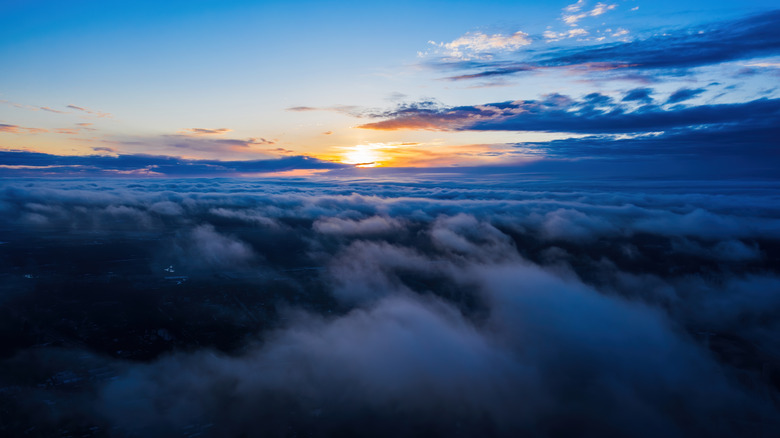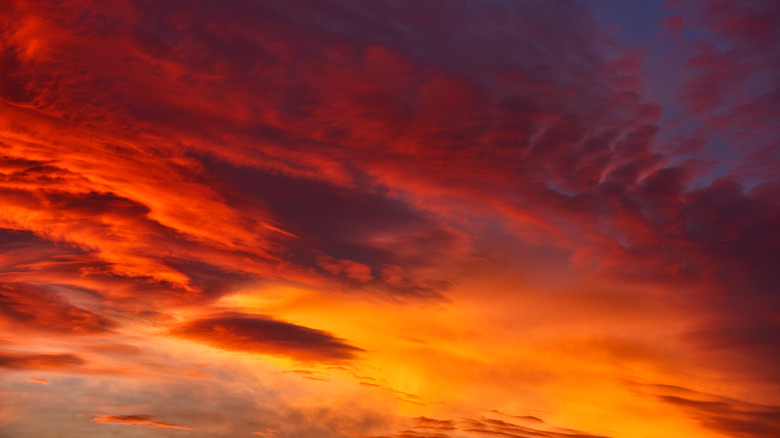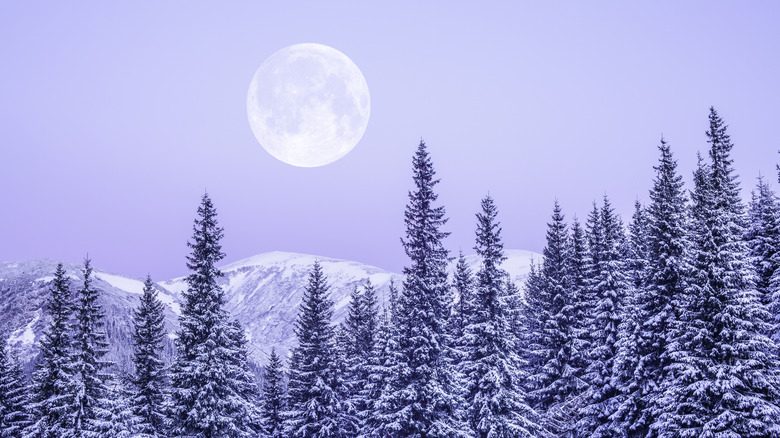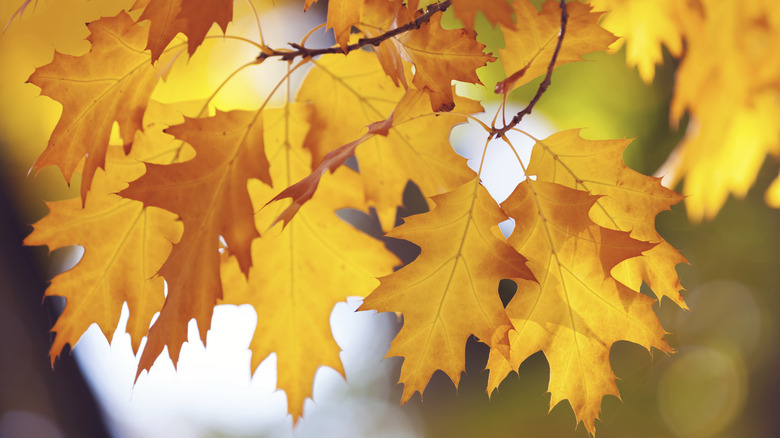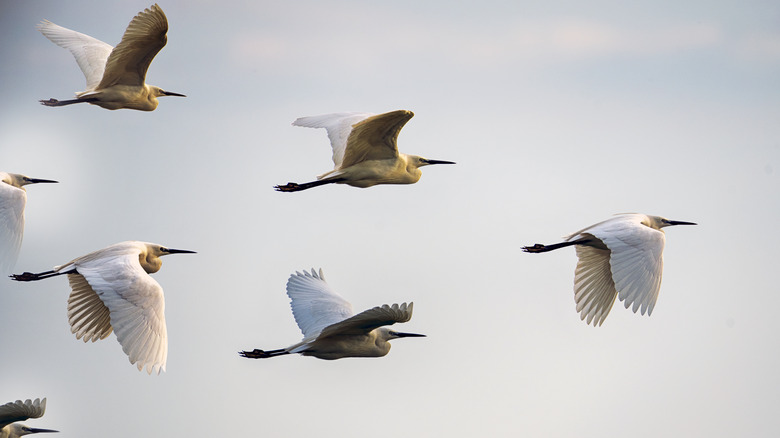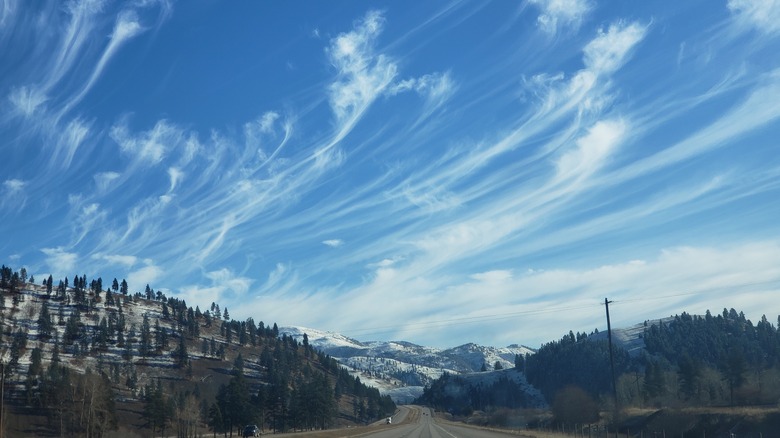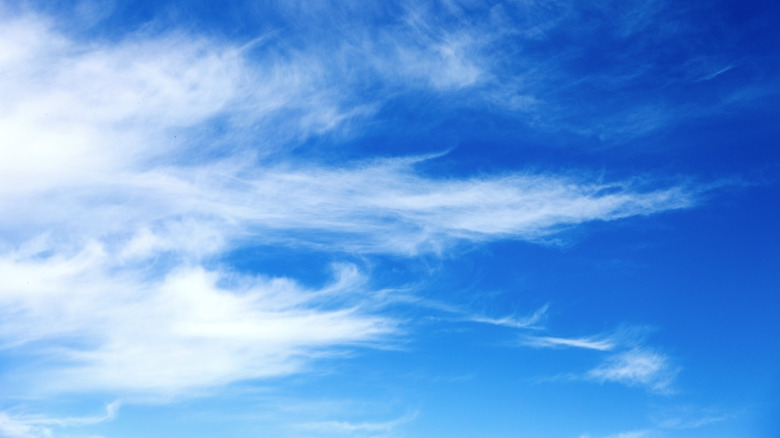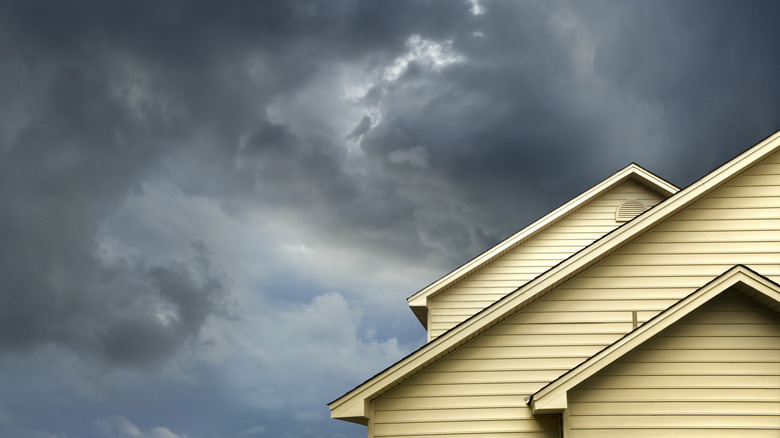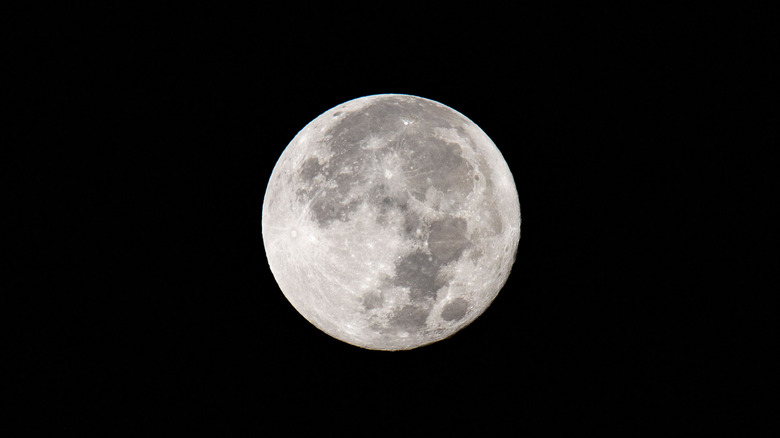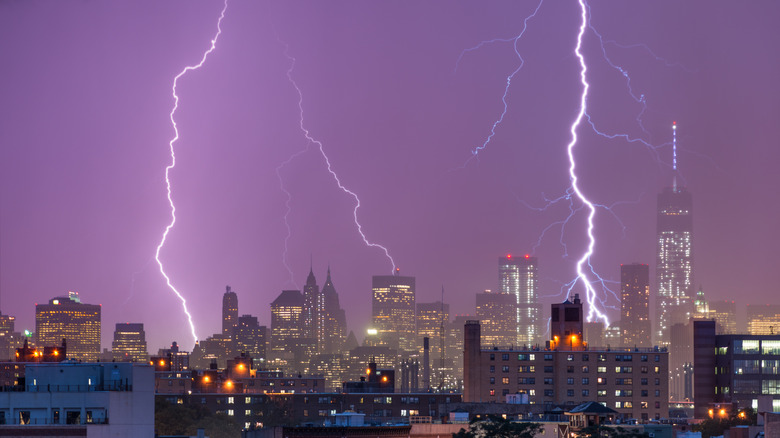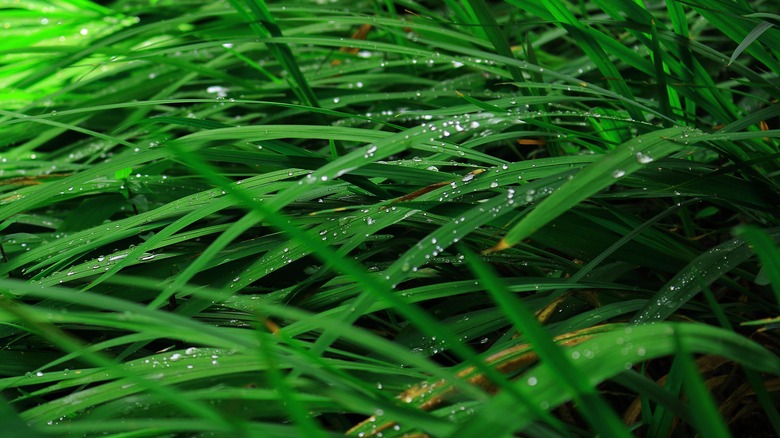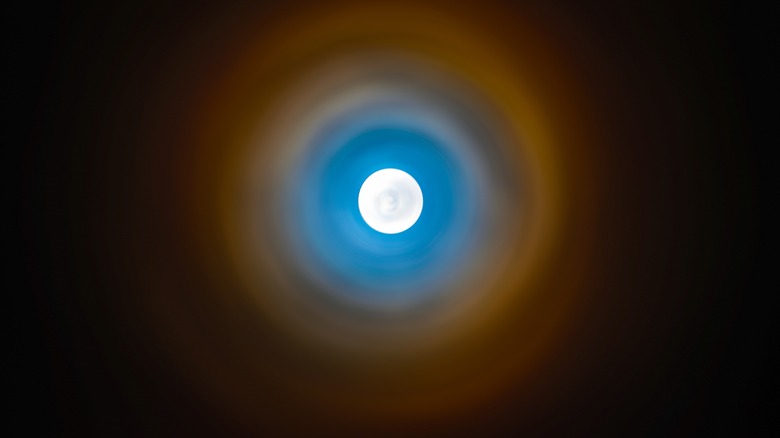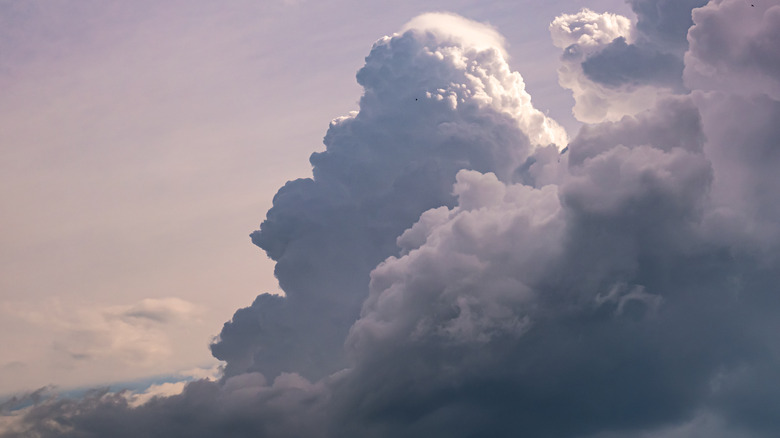What Red Sky At Night, Sailor's Delight And Other Weather Sayings Mean
In a time before electricity, phones, and advanced meteorology technology, there was weather folklore. These proverbs and beliefs were used to predict and prepare for unexpected bad weather by surveying nature, animals, the sky, and more. Like nursery rhymes, they roll off the tongue and are a delight, but the truth is individuals and early societies depended on weather folklore. Think of sailors on the sea eager to return home safely or farmers who needed to feed their families or sell their harvest. Being able to accurately interpret nature's patterns could make the difference in terms of survival.
Weather folklore might be helpful if you find yourself sans a weather app one day. Although less commonly used today in everyday conversations, these folksy sayings remain relevant. And while some adages are on the mark, we know now that others are a little flawed. Moreover, some sayings speak for themselves, while others need in-depth knowledge about the weather for deciphering.
Red Sky at night, sailor's delight, red sky in the morning, sailors take warning
According to the National Maritime Historical Society, William Shakespeare made mention of the logic behind the proverb in his poem, "Venus and Adonis." Likewise, The Field notes that there is a similar saying that states, "Red sky at night, a shepherd's delight. Red sky in the morning, a shepherd's warning." The publication reports that this is derived from the Bible, specifically Matthew 16:2-3, which reads (via Bible Gateway), "When it is evening, you say, 'It will be fair weather, for the sky is red.' And in the morning, 'It will be stormy today, for the sky is red and threatening.'"
This weather lore is, in fact, largely accurate. Storms usually move in from the west and into the east. If the sky is a red hue in the evening, there will be mild weather thanks to a westward high-pressure system. On the other hand, a red sky in the morning stipulates a low-pressure system, which means a storm could be brewing from an abundance of water vapor in the atmosphere. Be sure to keep this in mind next time you encounter a brilliant red sunrise or sunset.
Clear moon, frost soon
"Clear moon, frost soon" is simple and to the point. This saying refers specifically to the winter, fall, or spring seasons. It means that if no clouds are in sight at night, the following day will be cold. But is this accurate? The answer, again, is often yes, there is truth to this weather lore. Typically, the earth absorbs heat throughout the day and disperses it when the sun goes down.
Clouds aid in this process. But if the nighttime sky is clear, there's a problem; heat will not be trapped by the earth's surface, resulting in bitter temperatures and perhaps even a chance of frost. For reference, it has to be 32 degrees Fahrenheit and under for frost to form. Another way to say "clear moon, first soon" is "cold is the night when the stars shine bright." Radiant stars are another sign of clear skies, which, of course, could mean cooler temperatures.
When leaves turn their back, 'tis a sign it's going to rain
Rain is beloved by many and loathed by others. Even if rain isn't in the forecast, can you predict it using the proverb, "When leaves turn their back, 'tis a sign it's going to rain" or "When leaves show their undersides, be very sure rain betides?" You often can! That's because leaves from certain trees can react when a storm is heading its way. Yes, you read that right. Before impending rainfall, the leaves of oak, maple, and poplar trees are known to turn.
There are different reasons why this can happen. An incoming storm could raise humidity levels, causing the stems of leaves to soften (all the better for allowing stormy weather to turn them), and the more humidity there is, the more likely there is a storm on its way. In an article for WGN-TV, meteorologist Tom Skilling noted that this is associated with summer storms. However, even if an oak, maple, or poplar tree isn't around, check other trees. Wind can precede storms and cause the leaves to do the same thing.
If birds fly low, expect rain and a blow
Nature works in mysterious ways but can be used by humans to its advantage. For example, birds can be looked to to predict the weather. This is where the sayings "If birds fly low, expect rain and a blow," "Hawks flying high means a clear sky. When they fly low, prepare for a blow," and "If birds fly low, then rain we shall know" originate. Like trees, the behavior of birds can signify incoming rain, in their case, thanks to the changes in air pressure. When a storm approaches, the accompanying low-pressure system can affect how birds fly.
Dr. Roger Ledgerer, an ornithologist and emeritus Professor of Biological Sciences at California State University, Chico, explained in Yahoo! Money, "When the pressure is high, the air is denser, and the birds' wings have something to press against. Conversely, in lower air pressure systems, there are fewer molecules of air to press against, so it takes more effort and energy to fly." He went on to say that if a storm is imminent, birds will likely stay grounded to avoid this discomfort and eat.
Mares' tails and mackerel scales make lofty ships carry low sails
"Mares' tails and mackerel scales make lofty ships carry low sails" is an old sailor's proverb. This saying alludes to two types of clouds: cirrus and altocumulus. Cirrus clouds often appear feathery, like horse tails, and are thus known as mares' tails. On the other hand, altocumulus clouds create a distinct pattern in the sky that gives off a fish-scale-like appearance. You might have even heard these referred to as a "mackerel sky." This is due to moisture between the earth's surface and (the surrounding drier) atmosphere, per Spectrum News 1.
These clouds alerted sailors that they would soon be encountering a storm. In other words, there's some truth to this weather lore. Cirrus and altocumulus clouds manifest when a warm front is on its way. A warm front brings in rain and wind, explaining the related proverbs that state, "Mackerel sky, not 24 hours dry" and "Mackerel sky, mackerel sky — never long wet, never long dry." However, seeing these clouds does not mean the rain will be immediate. It will likely take hours or even a few days to start.
Trace in the sky the painter's brush, the winds around you soon will rush
While the origins of this proverb are unclear, it has nevertheless been around for centuries, as it was included in the 1869 book "Weather Lore; A Collection of Proverbs, Sayings, and Rules Concerning the Weather" by Richard Inwards. This saying is comparable to "Mares' tails and mackerel scales make lofty ships carry low sails." There is also truth to it. Like mares' tails, the "painter's brush" is talking about cirrus clouds and the less-than-ideal weather conditions their appearance signifies.
Cirrus clouds are wispy, and in Latin, their name translates to "curling lock of hair," according to The Guardian. As mentioned, cirrus clouds form before a warm front approaches, often signaling a change is imminent If you see cirrus clouds in the sky, the weather will likely change or soon take a turn for the worse. Think rain, wind, and fog.
When sounds travel far and wide, a stormy day will betide
This proverb implies that when a storm is on its way, you're more likely to be able to hear faraway sounds. While this idea might sound far-fetched, this phenomenon does happen. The humidity in the air increases before it rains, and air density decreases. A 1927 article from The American Magazine states that this is the perfect formula for sounds to travel long distances. The long-defunct publication explains that this prevents the sound waves from breaking or distorting more than they would if it were a day when a storm wasn't brewing, thus enabling your (temporary) hearing improvement.
This is because sound waves can easily travel with more humidity and moisture in the air. The opposite is true when the air is dry. Per Math Science Nucleus, this also explains why smells are heightened before it rains. Think about a balmy summer night; doesn't it seem like your senses are more alive? However, Grit Magazine reports that this proverb isn't always reliable, noting that it can be humid without the possibility of rain. Nevertheless, this weather lore could have been helpful to seamen or sailors in predicting if a storm was on its way.
Pale moon rains, red moon blows, white moon neither rains nor snows
Although it's over 238,000 miles from Earth (via NASA Space Place), the moon impacts the Earth's ocean tides and weather. At one point, the moon's appearance from Earth also influenced weather predictions through weather folklore. This can be seen reflected in the proverb, "Pale moon rains, red moon blows, white moon neither rains nor snows," which can also be written as, "Pale moon doth rain, red moon doth blow, white moon doth neither rain nor snow."
This proverb has legitimacy and indicates the possibility of snow. However, it makes more sense if you understand how snow occurs in the first place. With the help of water vapor, particles (these can be from dust, salt, or ash) can make three things: snow, snowflakes, or rain. Apparently, these particles give the water vapor something to cling to, a form for what it can become. According to Lit Hub, if the air is filled with dust particles, the moon will look pale or red, hence the interpretation that rain or snow is on the way. But if the moon is white, there's no dust, which means no rain or snow.
Lightning never strikes the same place twice
The beauty of a lightning storm can be alluring, but it can also be deadly. According to the CDC, an average of 28 people die annually from lightning strikes each year in the United States. To stay safe from this weather phenomenon, remain indoors at the first sound of thunder and away from anything that conducts electricity. Another word of advice? Don't believe the old but self-explanatory proverb that says, "Lightning never strikes the same place twice." This is not true.
Lightning develops when electricity gets discharged after negative and positive charges come together. This can happen repeatedly in the same place. Take, for instance, the iconic Empire State Building. In April 2011, it was struck by lightning three times in a row.
In addition, The Empire State Building's website states it gets struck by lightning 25 times a year. Due to their structure and ability to efficiently conduct electricity through lightning rods, towering buildings are especially susceptible to being struck more than once.
That said, the origins of this proverb are hazy. However, it has been around for some time, as it was mentioned in the 1860 book "Thrilling Adventures of the Prisoner of the Border" by Peter Hamilton Meyers. Although misleading, the proverb has persisted but is more commonly used to say that rare events are not widely repeated.
When dew is on the grass, rain will never come to pass
An extended version of this proverb states, "When dew is on the grass, rain will never come to pass. When grass is dry at morning light, look for rain before the night." This implies that dewy mornings equate to rain-free days. However, if there's no dew, then rain is expected. There is some legitimacy to this saying. For dew to form, the sky must generally be clear. On a clear night, heat from the ground moves up into the atmosphere, cooling the ground and forming dew.
Clear skies, of course, mean there will be no rain. Conversely, if the night is cloudy or windy, less heat will escape into the atmosphere, so the ground will not become cool enough for dew to form. Cloudy nights and wind are tall-tell signs of incoming rain. Nevertheless, this adage is not necessarily trustworthy. Weather can sometimes be unpredictable, and as noted by The Weather Prediction, it can change during the day.
If a circle forms around the moon, 'twill rain soon
As mentioned, looking at the moon can provide clues about the weather. Hence the sayings, "If a circle forms around the moon, 'twill rain soon," and its counterparts, "Ring around the moon, rain real soon," and "When a halo rings the moon or sun, rain's approaching on the run." These proverbs are unambiguous and have some truth to them.
The ring they speak of is also referred to as a lunar halo. Lunar halos appear when light bounces off of ice crystals, which are often suspended in cirrus clouds. They can be different colors, and the intensity of their hue depends on the quantity of light and cirrus clouds, per WHSV.
If past weather proverbs have taught you anything, it's that cirrus clouds are bad news. Scientist Brent McRoberts explained to The Eagle, "These types of clouds do not produce rain or snow, but they often are forerunners of a low-pressure system that could produce rain or snow in a day or two." In short, these proverbs may be based on facts but are generally considered undependable.
When clouds appear like towers, the Earth is refreshed by frequent showers
Another version of this proverb states, "When clouds appear like rocks and towers, the Earth will be washed by frequent showers." In either case, the clouds refer to cumulus clouds, specifically cumulus congestus clouds. These precede rain and thunderstorms. Likewise, the Farmers' Almanac states that cumulus congestus clouds are more likely to form in the summertime, and thunderstorms are more common during this season. Simply put, both sayings are accurate.
A cumulus cloud will appear round and fluffy. When you see these clouds, the weather is fair, and you have nothing to worry about. The problem arises when cumulus clouds begin to transform into cumulus congestus clouds. Instead of looking like a cotton ball, they will take on a cauliflower or tower-like appearance. This, in turn, will typically result in rain.
However, cumulus congestus clouds can also change into what is known as cumulonimbus clouds, and these are what causes thunder, lightning, and other unpleasant weather. Similar to cumulus congestus clouds, cumulonimbus clouds look like towers. If the clouds go from picturesque to threatening, you know bad weather is in store, proverb or not.
